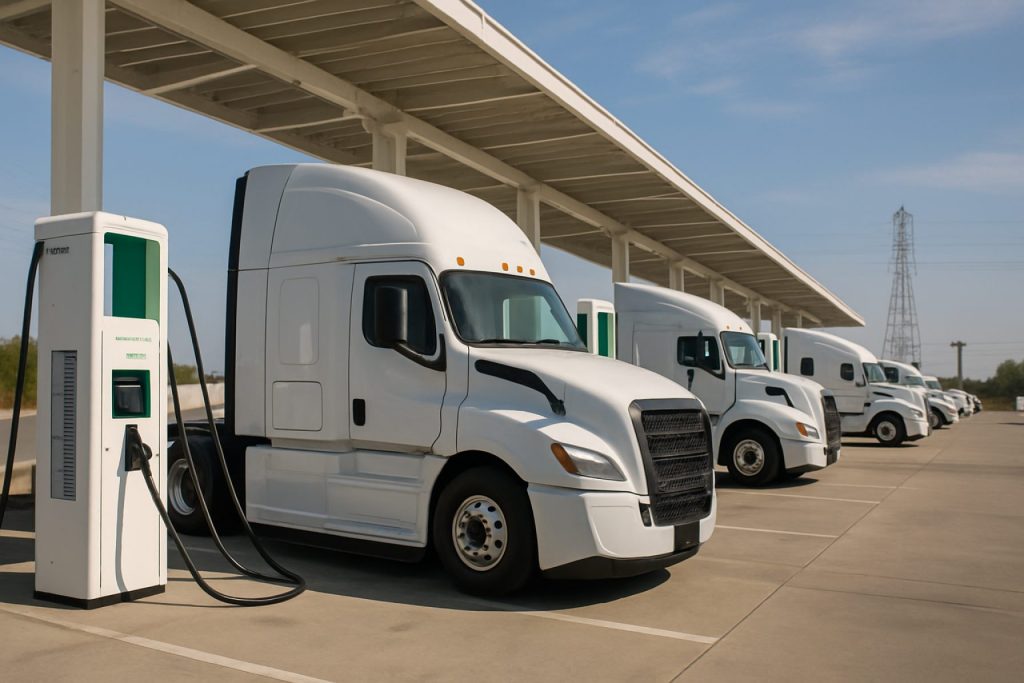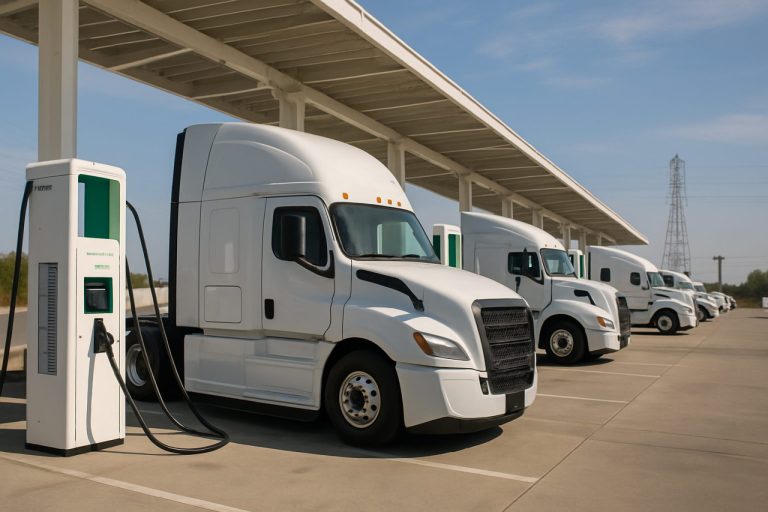
- NFI and Prologis Mobility have launched a cutting-edge electric truck charging depot in Ontario, California, supporting up to twenty Class 8 electric trucks daily.
- This initiative is a pivotal step in electrifying goods movement between the Ports of Los Angeles, Long Beach, and the Inland Empire warehouse region.
- Prologis Mobility has enabled over 10 million electric miles nationwide, emphasizing the growing scale and reliability of fleet electrification.
- The Ontario depot serves as a prototype charging hub, demonstrating scalable, zero-emission infrastructure for heavy-duty logistics.
- The partnership marks real progress toward cleaner air, streamlined logistics, and a sustainable future for freight transportation.
Palm trees sway against a backdrop of roaring highways in Ontario, California, now home to a game-changing alliance between NFI and Prologis Mobility. An unassuming lot—paved, sun-bleached, rimmed by chain-link—now hums with innovation at the heart of America’s goods movement.
Here, the air buzzes as ten powerful charging stations deliver a megawatt of electricity day and night, silently feeding up to twenty heavy-duty trucks daily. These aren’t your average delivery vehicles; these are Class 8 electric giants, some of the first in the nation to haul everything from electronics to fresh produce between the bustling Ports of Los Angeles and Long Beach and the vast warehouse corridors of the Inland Empire.
This depot forms the backbone of NFI’s growing fleet—nearly 90 electric trucks strong—shuttling containers in zero-emission silence where diesel engines once roared. As these rows of Volvo VNR Electrics and Freightliner eCascadias wait their turn at the charger, the logistics world takes note: the once-daunting barrier of charging access is beginning to dissolve.
Prologis Mobility has already powered over 10 million electric miles for fleets nationwide, a testament to its commitment to turnkey infrastructure. The company’s mission is both practical and visionary: build charging hubs that can keep up with the relentless pace of modern logistics, from depot to distribution center.
This is more than a local story. The Ontario depot acts as a prototype—one node in a growing network transforming how cargo moves across American highways. With carefully selected sites in major freight corridors, Prologis Mobility and partners like NFI are proving that electrification isn’t just possible; it’s inevitable.
Across the industry, momentum is building. Fleet operators seek consistency, reliability, and scale. The promise is grand: cleaner air for residents, streamlined logistics for businesses, and a new blueprint for tackling one of freight’s greatest modern challenges.
The message is clear and unmistakable: The future of trucking is electric—and it charges here, under the California sun.
To learn more about the transformation of logistics and the evolution of electric transportation, visit Prologis and NFI.
Takeaway: The transition to electrified freight has left the lot—charging infrastructure is fueling a new era of emission-free, efficient cargo movement that’s rolling on real California roads today.
The Future of Trucking: How California’s Electric Truck Depot Sets a National Standard
The Electric Revolution in Freight: Beyond the Buzz
California’s Inland Empire, once known only for its sprawling warehouses and bustling freeways, is quickly becoming a proving ground for the largest scale-up in electric trucking North America has seen. While the partnership between NFI and Prologis Mobility was highlighted as a regional milestone, the implications extend far beyond Ontario, CA. Here, we’ll dive deeper into key facts, actionable how-tos, real-world use cases, and industry trends—addressing the most pressing questions about electric trucking and the infrastructure powering it.
Key Additional Facts
1. Types of Electric Trucks at the Depot
– Volvo VNR Electric: Offers a range of up to 275 miles per charge, with rapid charging technology that allows an 80% charge in 90 minutes (source: Volvo Trucks).
– Freightliner eCascadia: Designed for local and regional distribution, with up to 230 miles range, DC fast charging under 90 minutes, and industry-leading telematics (source: Daimler Truck North America).
2. Charging Infrastructure Details
– Megawatt-Scale Charging: California requires charging hardware up to 1 MW to support rapid turnaround for Class 8 trucks, dramatically reducing downtime vs. commercial Level 2 AC chargers.
– Smart Load Management: The site features energy management software to stagger charging, optimize grid use, and minimize peak charges—vital in California’s high-cost energy environment.
– Scalability: Prologis Mobility’s model is modular, permitting rapid expansion to dozens or even hundreds of trucks as fleets grow.
– Grid Resiliency: Some depots—like Ontario—are evaluating battery storage and on-site solar to support sustained operations during outages or grid stress (source: California Energy Commission).
3. Market Forecasts & Industry Trends
– Fleet Electrification Is Accelerating: ACT Research forecasts that by 2030, electric trucks could make up 25% of new Class 8 truck sales in North America, up from less than 1% in 2022.
– California as the Catalyst: Due to its Advanced Clean Trucks Rule, fleets operating in California must transition to increasing proportions of zero-emission trucks starting in 2024—compelling major logistics operators to invest now.
– Leading Investment: According to McKinsey, logistics and warehousing industries are on track to invest over $60 billion in EV infrastructure by 2030.
How-To Steps: Transitioning to Electric Fleets
1. Assess Route Feasibility: Use telematics to identify routes under 250 miles (currently most suitable for electric trucking).
2. Plan Infrastructure: Partner with providers like Prologis for custom depot solutions that right-size charging facilities for your fleet.
3. Secure Incentives: Leverage programs such as California’s Hybrid and Zero-Emission Truck and Bus Voucher Incentive Project (HVIP) to offset truck and infrastructure costs.
4. Pilot & Scale Up: Deploy electric trucks on select routes, closely track performance and costs, then gradually transition remaining fleet segments.
5. Train & Support Drivers: Invest in driver education for EV operation and real-time telematics to maximize range and uptime.
Life Hacks & Real-World Use Cases
– Night Charging: NFI staggers truck charging overnight when grid demand (and rates) are lowest, reducing costs by up to 30%.
– Maintenance Savings: Fleets report reduced annual maintenance costs by as much as 40%, as electric trucks have fewer moving parts (source: North American Council for Freight Efficiency).
– Quiet Zones: Local jurisdictions note a dramatic reduction in noise pollution—enhancing community relations near busy depots.
Pros & Cons Overview
Pros
– Zero Tailpipe Emissions: Immediate air quality improvements for communities near major freight corridors.
– Lower Fuel & Maintenance Costs: Estimated $0.20 per mile savings over diesel (source: CALSTART).
– Incentives Available: Significant grants and tax credits available, especially in California.
Cons & Limitations
– Range Anxiety: Most current models top out below 300 miles per charge, limiting very long-haul applications.
– Initial Cost Premium: Electric Class 8 trucks can be twice the upfront cost of diesel, though TCO (total cost of ownership) may be lower over the lifetime.
– Charging Infrastructure Dependencies: High upfront investment and complex power requirements—advanced planning is crucial (link: Prologis).
Security & Sustainability
– Grid Security: Prologis is working closely with utilities to ensure new truck charging doesn’t strain local grids, leveraging energy storage and smart-charging tech.
– Sustainable Sourcing: Use of renewables (e.g., on-site solar) further reduces lifecycle emissions.
Pressing Questions Answered
Q: Will cargo capacity or route speeds be affected?
A: Most current electric Class 8 models carry standard payloads and have torque equal to or exceeding diesel counterparts; however, very long routes and hilly terrain can reduce effective range.
Q: How long until electric trucking is “the norm”?
A: Industry experts predict mass adoption between 2027 and 2035, with California leading the way due to regulatory pressure and infrastructure advances (source: Rocky Mountain Institute).
Q: How are costs evolving?
A: Battery prices have fallen 89% in 12 years (BloombergNEF); parity with diesel is likely by the late 2020s, especially as scale and tech improve.
Expert Insights & Predictions
– Industry Analysts anticipate public-private collaborations will accelerate, with federal infrastructure dollars flowing into major freight corridors nationwide.
– Comparison: The US and China are in a “green freight race,” with California’s adoption rate among the highest outside Asia.
Actionable Quick Tips
– Fleet managers: Start now by electrifying your shortest urban routes—this delivers fast ROI and helps win public contracts with clean-fleet requirements.
– Shippers: Partner with carriers adopting electric trucks—this advances your own ESG (Environmental, Social, and Governance) goals.
For more on cutting-edge clean logistics, visit Prologis and NFI.
—
Takeaway:
The electric freight revolution is here, led by innovative California partnerships. Early adopters who embrace infrastructure, incentives, and real-world data will gain the most—while helping drive cleaner air and more robust logistics nationwide. Now’s the time to plug in.



